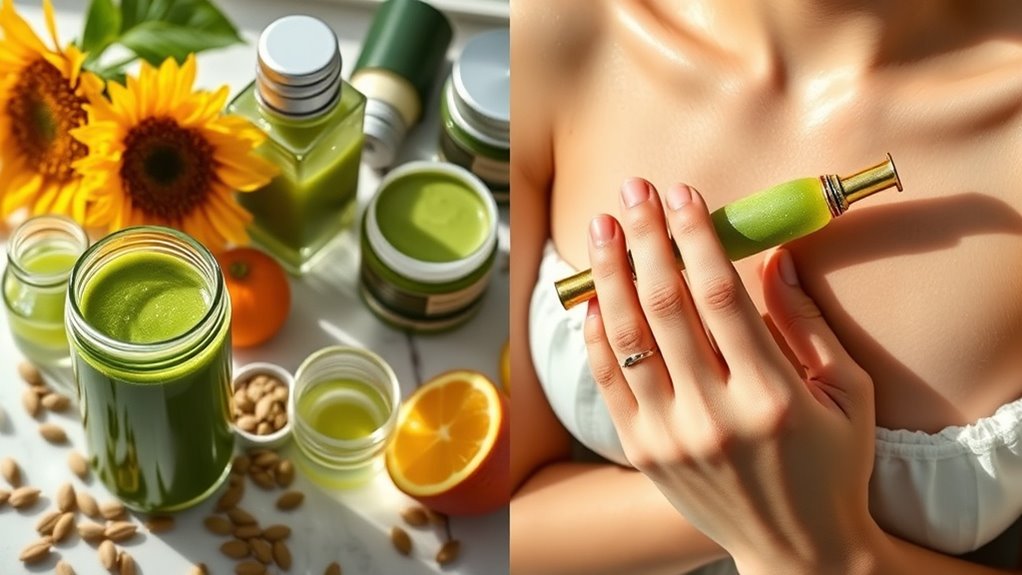Cold Weather Wreaking Havoc. Try This Winter Skincare Plan
As cold weather strips your skin’s moisture, causing dryness and irritation, you’ll combat it by using hyaluronic acid to draw in hydration and ceramide creams to seal it in. Moisturize twice daily, stay hydrated, apply sunscreen, and opt for gentle cleansing to protect your barrier. Don’t skip antioxidant-rich foods or hot showers that’ll strip oils. Follow these steps, and you’ll uncover more ways to keep your skin resilient through winter.
Key Takeaways
- Use hyaluronic acid serums to draw moisture into dry, dehydrated skin.
- Apply ceramide-rich creams after cleansing to repair and strengthen the skin barrier.
- Moisturize twice daily, focusing on vulnerable areas like cheeks and hands.
- Layer products with antioxidants like vitamin C to neutralize free radicals and brighten complexion.
- Adopt daily habits such as gentle cleansing, drinking water, and applying sunscreen for protection.
Understanding Winter Skin Challenges
As winter sets in, you’ll find your skin facing unique challenges from cold air, low humidity, and indoor heating, which strip away natural moisture and weaken its barrier. Incorporating moisturizing techniques is key to restoring and maintaining your skin’s hydration in harsh conditions.
These factors cause dryness, irritation, and a compromised protective layer, making your skin more vulnerable to environmental stressors.
Winter skincare tips emphasize recognizing how cold winds accelerate moisture loss, while low humidity draws water from deeper layers, leading to flakiness and sensitivity.
You’ll notice increased redness or tightness, so monitoring these signs helps maintain skin health through informed awareness.
Stay vigilant to prevent long-term damage.
To address these issues effectively, it’s essential to differentiate dehydrated skin from dry skin by noting signs like temporary moisture loss versus a lack of natural oils.
Key Moisturizing Techniques for Cold Weather
To combat winter’s drying effects, you’ll need targeted moisturizing techniques that seal in hydration and strengthen your skin’s barrier. Additionally, incorporating lifestyle changes such as increasing water intake can further support your skin’s natural moisture balance.
Choose humectants like hyaluronic acid, which research shows can hold up to 1000 times its weight in water, drawing moisture deep into your skin.
Apply a ceramide-rich cream immediately after cleansing to lock in that hydration—use upward motions for even coverage.
For optimal results, moisturize twice daily, focusing on dry areas like hands and cheeks; evidence supports this routine reduces flakiness by enhancing skin elasticity.
Always select fragrance-free formulas to minimize irritation.
Hyaluronic acid is recognized as the most effective moisturizing ingredient for achieving radiant skin quickly.
Protective Layers for Your Skin Barrier
Protect your skin barrier from environmental threats like wind and pollution by layering products that mimic its natural structure. This approach strengthens your skin’s defenses, drawing on dermatological research to prevent moisture loss and damage. Additionally, when choosing products for this routine, prioritize avoiding toxic ingredients to safeguard your skin’s health.
By building protective layers, you’re fortifying against harsh elements effectively.
-
Start with a humectant: Apply hyaluronic acid to attract and retain water, enhancing barrier hydration based on clinical studies.
-
Add an emollient: Use ceramides or fatty acids to repair and fill gaps in your skin’s lipid matrix, promoting resilience.
-
Layer on an occlusive: Seal with petrolatum or oils to lock in moisture, as evidenced by barrier function tests.
-
Incorporate antioxidants: Top with vitamin C or E to neutralize free radicals from pollution, supported by environmental dermatology.
To maximize the benefits of this method, consider timing application for sustained hydration throughout the day.
Daily Habits to Maintain Skin Health
Maintaining vibrant skin health requires just a few consistent daily habits, backed by research on barrier function and longevity.
You must cleanse gently twice daily to preserve your skin’s natural barrier, as studies confirm this reduces irritation.
Stay hydrated by drinking ample water; evidence shows it boosts elasticity and fights dryness.
Protect against UV rays with daily sunscreen application, even in winter, to prevent aging, per dermatology research.
Avoid hot showers and harsh soaps—they strip oils and compromise your barrier. Another common mistake is over-exfoliation, which can lead to increased skin sensitivity and barrier damage during winter.
Prioritize a nutrient-rich diet; antioxidants from fruits and veggies enhance skin resilience, supporting long-term health.
By prioritizing sunscreen application, you can effectively prevent premature aging and skin damage as the most essential anti-aging measure.
Revitalizing Products for Winter Recovery
As winter’s harsh conditions deplete your skin’s moisture and barrier, you’ll find that incorporating evidence-based revitalizing products speeds recovery. Additionally, exploring retinol alternatives from natural sources can further support skin resilience against aging effects during colder months.
These dermatologist-recommended items restore hydration and strengthen defenses, drawing from studies on barrier repair and antioxidants.
-
Hyaluronic acid serum: Boosts moisture levels by attracting water, as shown in clinical trials, to plump dehydrated skin.
-
Ceramide cream: Rebuilds the lipid barrier, per research, to lock in hydration and reduce irritation.
-
Vitamin C product: Neutralizes free radicals from cold stress, backed by evidence, for brighter, resilient complexion.
-
Peptide-infused oil: Enhances collagen production, supported by studies, to firm and heal winter-damaged areas.
Furthermore, a vitamin C product can effectively address hyperpigmentation to promote an even skin tone, drawing from research on its skin-brightening properties.





